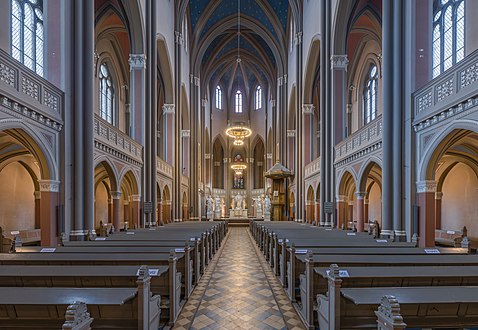
Wiesbaden is the capital of the German state of Hesse, and the second-largest Hessian city after Frankfurt am Main. With around 283,000 inhabitants, it is Germany's 24th-largest city. Wiesbaden forms a conurbation with a population of around 500,000 with the neighbouring city of Mainz. This conurbation is in turn embedded in the Rhine-Main Metropolitan Region—Germany's second-largest metropolitan region after Rhine-Ruhr—which also includes the nearby cities of Frankfurt am Main, Darmstadt, Offenbach am Main, and Hanau, and has a combined population exceeding 5.8 million.

St. Catherine's Church is the largest Protestant church in Frankfurt am Main, Germany. It is a parish church in the old city centre near one of the most famous city squares, the Hauptwache. The church is dedicated to the martyred early Christian saint Catherine of Alexandria.
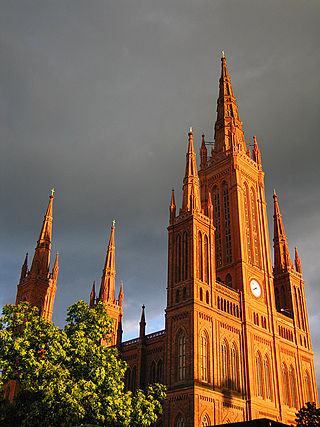
Hans Uwe Hielscher is a German organist and composer. He was organist and carillonneur at the Marktkirche in Wiesbaden, Hesse, Germany, from 1979 to 2009, and has played internationally as a concert organist.

Kurt Georg Hugo Thomas was a German composer, conductor and music educator.
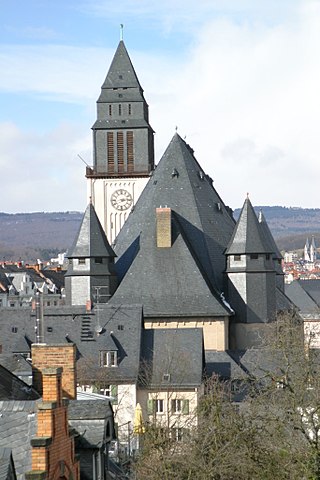
The Lutherkirche is one of four main Protestant churches in Wiesbaden, the capital of Hesse, Germany. It was built between 1908 and 1910 in Jugendstil and in accordance with the Wiesbadener Programm, to a design by Friedrich Pützer. With two organs and good acoustics, it is also a concert venue.

The Rheingau Musik Festival (RMF) is an international summer music festival in Germany, founded in 1987. It is mostly for classical music, but includes other genres. Concerts take place at culturally important locations, such as Eberbach Abbey and Schloss Johannisberg, in the wine-growing Rheingau region between Wiesbaden and Lorch.

The Reger-Chor is a German-Belgian choir. It was founded in Wiesbaden in 1985 and has been conducted by Gabriel Dessauer in Wiesbaden. Since 2001 it has grown to Regerchor-International in a collaboration with the organist Ignace Michiels of the St. Salvator's Cathedral of Bruges. The choir performs an annual concert both in Germany and Belgium of mostly sacred choral music for choir and organ. Concerts have taken place regularly in St. Bonifatius, Wiesbaden, and in the cathedral of Bruges in its series "Kathedraalconcerten". The choir performed additional concerts at other churches of the two countries and in the Concertgebouw of Bruges.

St. Martin is the name of a Catholic parish and church in Idstein, Rheingau-Taunus-Kreis, Germany. The official name of the church is Katholische Pfarrkirche St. Martin. The name of the parish became St. Martin Idsteiner Land on 1 January 2017, when it was merged with five other parishes. The parish is part of the Diocese of Limburg.

Elisabeth Scholl is a German soprano and academic teacher.

Gabriel Dessauer is a German cantor, concert organist, and academic teacher. After studies with Diethard Hellmann and Franz Lehrndorfer, he was responsible for the church music at St. Bonifatius, Wiesbaden from 1981 to 2021, conducting the Chor von St. Bonifatius until 2018. Besides normal church services, he conducted them in regular masses with soloists and orchestra for Christmas and Easter and a yearly concert. In 1995 he prepared the choir for a memorial concert commemorating the 50th anniversary of the end of World War II, performing Britten's War Requiem with choirs from countries involved in the war, and concerts in Wiesbaden and Macon, Georgia. Programs of choral concerts included Hermann Suter's Le Laudi in 1998, the German premiere of Rutter's Mass of the Children in 2004, and the world premiere of Colin Mawby's Bonifatiusmess in 2012 which he had commissioned for the choir's 150th anniversary. The concert of 2008, Vivaldi's Gloria and Haydn's Nelson Mass, was also performed at San Paolo dentro le Mura in Rome.
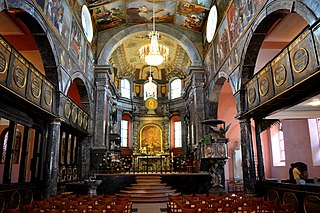
The Unionskirche is the active Protestant parish church of Idstein, a town in the Rheingau-Taunus district in the German state of Hesse. Idstein was a residence of the counts of Nassau. The church building in the center of the historic Altstadt dates back to the 14th century when it was built as a collegiate church. It became Lutheran during the Reformation. Its interior was adapted in the 17th century to become a Lutheran Predigt- und Hofkirche. The most prominent decoration in the church is the series of 38 paintings by the Flemish painter Michael Angelo Immenraedt, an exponent of Flemish Baroque painting, and others. They follow a program of biblical scenes.

Schiersteiner Kantorei is a German concert choir, founded in 1962 at the Christophoruskirche in Wiesbaden-Schierstein. The choir performs regularly in the Marktkirche, Wiesbaden, and in Eberbach Abbey. It is known internationally through its tours and recordings. The choir was awarded the Culture Prize of the City of Wiesbaden in 1990.
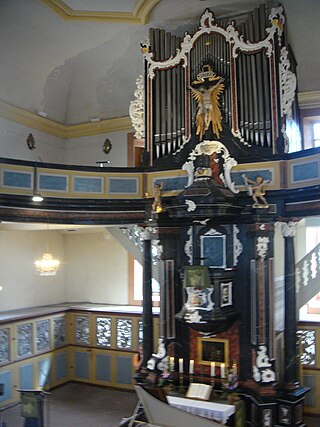
Martin Lutz is a German musicologist, conductor and harpsichordist. He was the musical director of the concert choir Schiersteiner Kantorei in Wiesbaden from 1972 to 2017, and founded the biennial festival Wiesbadener Bachwochen in 1975.

The Christophoruskirche is a Protestant church in the borough of Schierstein, Wiesbaden, Germany. It was built in 1752 to 1754 in the style of the late Baroque and Rococo.
Berthold Klemens Possemeyer is a German baritone in opera and concert, and a voice teacher at the University of Music and Performing Arts in Frankfurt am Main.

Rheingauer Kantorei, now Neue Rheingauer Kantorei, is a mixed choir of the Rheingau region in Germany, performing mostly sacred music in services and concerts.
Frank Stähle was a German musician, a choral conductor and the director of Dr. Hoch's Konservatorium in Frankfurt from 1979 to 2007.
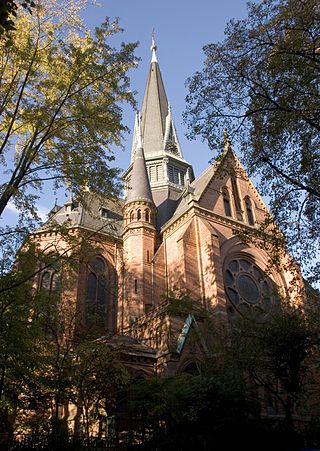
The Bergkirche is one of four main Protestant churches in Wiesbaden, the capital of Hesse, Germany. It was completed in 1879 in Gothic Revival based on a design by Johannes Otzen. The church is focused on having the altar and pulpit close to the congregation, following Luther's concept of a universal priesthood. It also serves as a concert venue for church music.

Wiesbadener Bachwochen is a biennial festival of music around Johann Sebastian Bach in Wiesbaden, the state capital of Hesse, Germany. It was initiated and has been run by Martin Lutz. The city awards the Bachpreis der Landeshauptstadt Wiesbaden to an organist who wins the festival's international competition.
Clemens Bosselmann is a German conductor and church musician, working since 2018 as director of music (Kantor) at the Christophoruskirche in Wiesbaden-Schierstein, Hesse. He is the choral conductor of the concert choir Schiersteiner Kantorei where he expanded the concert choir's repertoire with 20th-century music and rarely performed choral works.






